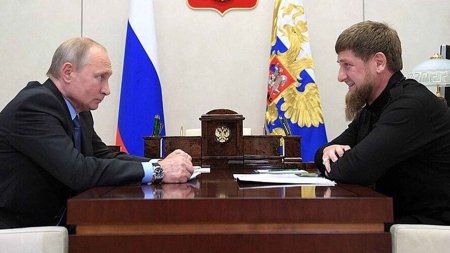
Russia Pushes for Republican Units in the North Caucasus to Fight in Ukraine
Publication: Eurasia Daily Monitor Volume: 19 Issue: 95
By:

One after another, authorities in the North Caucasus republics are announcing the creation of volunteer units for fighting Ukraine. The Russian military command proposed the establishment of a Dagestani rifle company on the basis of the 136th Separate Guards Motorized Rifle Brigade, stationed in Buinaksk, Dagestan. On June 16, Colonel Sergei Pavlenko, the head of the topographic service of the Southern Military District staff met the leader of Buinaksk, Islamudin Nurgudayev. Pavlenko stated that all Russian regions are expected to form such units. According to Pavlenko, contracts with regular Russian military benefits are signed for three months with the possibility of renewal. Men up to age 50 are invited to join the unit. After brief training in Buinaksk, the company will be dispatched to the training grounds in the Russian-occupied part of Ukrainian Donetsk region (Chernovik, June 16). A typical motorized rifle company in the Russian military is comprised of 100–120 soldiers.
Kalmykia, which borders Dagestan from the north, is also preparing to dispatch a company of volunteers to the Ukrainian front line. The governor of Kalmykia, Batu Khasikov, announced a sign-up bonus of 30,000 rubles (ca. $550) for volunteers (Kavkazsky Uzel, June 4). In Ingushetia, on orders from the Russian Ministry of Defense, regional authorities are forming an Ingush company within the 34th Separate Motorized Rifle Brigade (Sunja-ri.ru, June 21). Sources say that the authorities in Ingushetia plan to recruit 94 people and train them for a month on the basis of the 503rd Motorized Rifle Regiment stationed in the village of Troitskoye, in Ingushetia’s Sunzhensky District. Ingushetian authorities promise a 100,000 rubles (ca. $1,800) sign-up bonus along with 300,000 rubles (ca. $5,500) per month (including all benefits) from the Russian government (Gazetaingush.ru, June 25).
Some ethnically labeled units are already operational in Ukraine. Chechen militarized forces under the de facto control of republican head Ramzan Kadyrov have been in Ukraine since the start of the Russian incursion in February 2022. Kadyrov has been vocal on social media about supporting Russia’s invasion of Ukraine with manpower.
Other North Caucasus governors, with the exception of the North Ossetian ruler, have been far more reticent about the war in Ukraine. In June, North Ossetia’s Governor Sergei Menyailo unexpectedly stated that a North Ossetian battalion was fighting in Ukraine and that it had been reinforced with a tank unit. The posted video showed several old T-62 tanks driving down the road. The officer who was reporting to Menyailo in the video appeared to be an ethnic Russian. One tank had an Ossetian flag on it. Two tanks had names of North Ossetian towns written on them (Region15.ru, June 20). A typical motorized rifle battalion in the Russian military is comprised of about 800 soldiers.
Menyailo was sanctioned by the United States Department of the Treasury on June 20, 2014, for being responsible for actions against Ukraine’s territorial integrity. In 2020, when Menyailo served as Russian President Vladimir Putin’s envoy to the Siberian Federal District, he was sanctioned again by the European Union and the United Kingdom for his involvement in poisoning Russian opposition leader Alexei Navlany (Treasury.gov, March 2, 2021). Menyailo participated in the Russian annexation of Crimea in 2014 and served as the governor of Sevastopol from 2014 to 2016. Previously, until 2011, Menyailo was deputy commander of the Russian Black Sea Fleet stationed in Crimea. Putin appointed Menyailo as the governor of North Ossetia in April 2021.
The creation of republican units for war in Ukraine demonstrates the manpower shortages that the Russian military faces. The Russian State Duma (lower chamber of parliament) Defense Committee recently approved amendments allowing school graduates to enter military-service contracts immediately, rather than after three months of mandatory military service as at present (Interfax, June 26). The idea is that military units named after republics will attract more recruits from those republics. Ethnic-Russian-majority regions do not have the same advantage, as regional identities there are too weak to mobilize people effectively. Hence, so far, little information has been released about the creation of a Ryazan regiment or Pskov company, even though people are certainly recruited in those areas too.
The campaign for setting up the republican units might also have some political objectives. North Caucasus republics have been the least supportive of war in Ukraine among Russian regions (see EDM, June 7). With the creation of republican military units, regional media will follow the activities of their respective units in Ukraine, which presumably should help boost popular support for the Russian war against its neighbor.
That said, units fighting in Ukraine named after republics are unlikely to have a significant impact either on Russia’s war effort or on popular support for it in the North Caucasus. The newly formed units’ personnel strength appears to be small. North Caucasians have suffered significant casualties, and despite large financial incentives, most people will likely conclude that the risks are not worth it. Dozens have refused to fight. About 270 servicemen from the North Caucasus have been killed in Ukraine according to official information (likely significantly underreported) as of mid-June (Kavkazsky Uzel, June 17).
The governors’ rallying call is also likely to fall on deaf ears. Republics in the North Caucasus do not elect their governors. Instead, their leadership is appointed by Moscow. This results in docile governors who report to Moscow and do not depend on their constituents in the region. The reverse side of Moscow’s control over regional governors is that they lack support among local populaces. While Russian authorities can still implement policies via the government machine, subsidies, and other incentives, stirring genuine patriotism among the people in the periphery is beyond the ability of pliable and politically neutered leaders.



